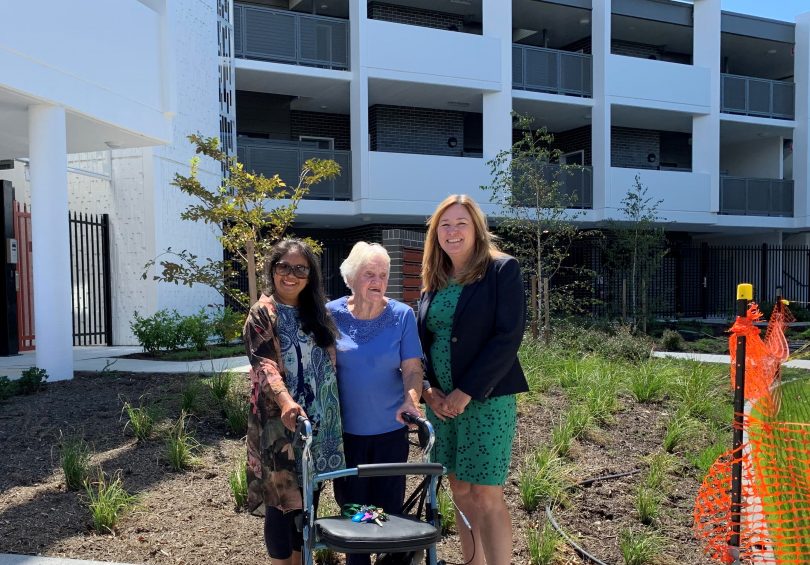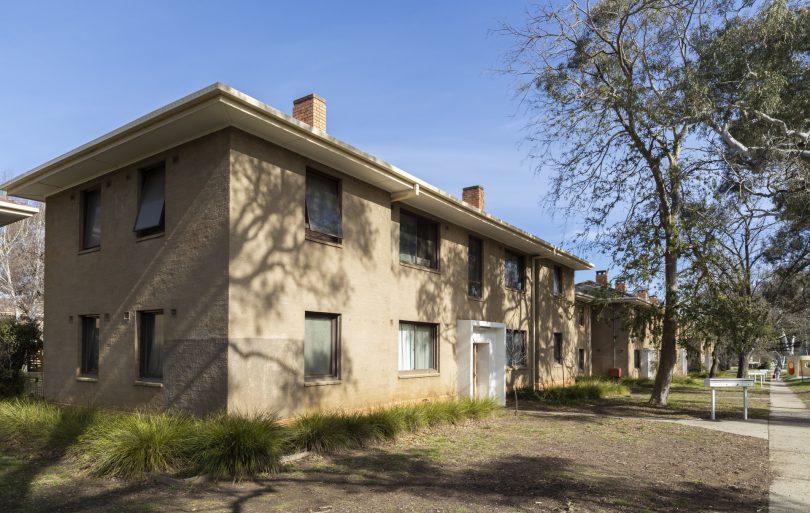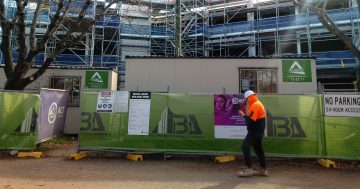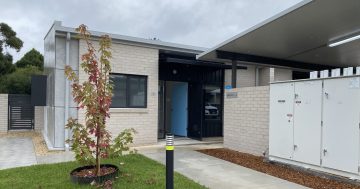
Tenants Novy Forcadas and Pat Bailey, pictured with Housing Minister Yvette Berry, relocated from older homes nearby to move into this new building in Dickson a year ago. Photo: ACT Government
Housing ACT has begun officially notifying more than 300 public housing tenants that they will have to relocate as part of the ACT Government’s renewal program.
The program has been focusing on its several thousand strong stock of three-bedroom houses across Canberra and asking tenants to move out so the sites can either be sold to generate re-investment funds or redeveloped to build modern homes.
Since the beginning of the Growing and Renewing Public Housing program in May 2019, a total of 336 households have chosen to be relocated, with 173 properties sold and 101 slated for redevelopment. Sixty-two households are still to be found a new home.
Housing ACT engaged with 687 households and directly asked 580 tenants to relocate, and 270 have been relocated or are relocating right now, but it says this is not enough to keep the renewal program running, and the government has to make some tough decisions.
They say tenants have been approached multiple times, but the point has been reached where relocations are required.
The 314 targeted tenants received letters today (21 February) advising they will have to move, but they will be offered support.
A government spokesperson said this did not mean households would be evicted. The timeline for relocation varies case by case and depends on individual tenant needs and the availability of appropriate properties that meet these needs.
While the focus has been on larger homes, not all tenants are in properties of three bedrooms or more.
“The properties identified for sale or redevelopment can be located across all suburbs of Canberra and are older, inefficient houses that no longer meet the needs of tenants, are expensive to maintain or have reached the end of their useful life,” the spokesperson said.
Officials say eviction will be a last resort, with tenants given multiple opportunities to choose a home to go to, even if the matter gets to the ACT Civil and Administrative Appeals Tribunal.

Public housing in Reid. Target households are located across Canberra. Photo: Michelle Kroll.
They will also be connected to support organisations such as Shelter ACT and Woden Community Service and legal advice through Canberra Community Law.
“Housing ACT is committed to supporting tenants before, during and after their move,” the government spokesperson said.
“We work closely with tenants, their support networks and community service providers, as part of an extensive engagement process, to relocate tenants to alternative housing.
“The relocation of tenants includes identifying individual support needs, finding the right home, help with moving, and ensuring access to any supports needed after moving.”
Housing ACT has also provided an update of the current program, which has a pipeline of 800 homes.
It also includes measures to ensure it will meet its goals by 2025 despite material and labour shortages due to the national construction boom, COVID-19 lockdowns, supply chain issues and wet weather.
The program aims to add 400 new homes to the portfolio, a figure boosted by 140 thanks to the Greens-Labor parliamentary agreement, and deliver a total of 1400 modern homes overall.
The goal is to sell 700 houses and reinvest the proceeds into a development program that would include the demolition of 300 properties on which 700 new homes would be built and the construction of 420 greenfield properties.
Housing ACT will also go to market to acquire 140 properties.
Over the first two and a half years of the program, 143 dwellings have been bulldozed for redevelopment and 242 public housing properties sold, generating just over $195 million.
Housing ACT has spent more than $58 million buying more than 100 blocks from the Suburban Land Agency and the Asbestos Response Taskforce, completed 157 dwellings at a cost of $96 million, and also bought 76 dwellings for $52 million from the market, mostly larger properties with three or more bedrooms.
This year it will demolish a further 91 properties for redevelopment, buy 22 blocks from the SLA, and deliver 116 new constructions. It will buy 69 dwellings from the market, with five to be settled this year and the rest progressively throughout the next two years because of contract dates.
Normal construction time frames for a standard project have blown out from nine to 10 months to about 15 months, so Housing ACT has revised its work schedule to ensure that the program hits its targets by the end of 2024-25.
Housing ACT aims to have properties in every Canberra suburb. Between 2015 and 2019 it relocated 1288 tenants from 13 multi-unit properties to smaller density homes across Canberra.
Public housing stock makes up 7 per cent of Canberra homes, including Gungahlin 4 per cent, Belconnen 8 per cent, Molonglo Valley 6 per cent, Tuggeranong 8 per cent, Weston Creek 8 per cent, North Canberra 10 per cent, South Canberra 5 per cent and Woden Valley 6 per cent.
Welfare and community organisations continue to argue that the renewal program will still leave a shortfall of housing in the ACT. Around 4000 people remain on Housing ACT’s waiting list, including 485 on the priority waitlist.



















